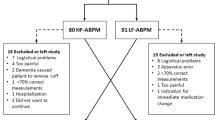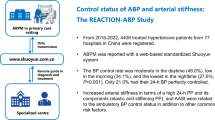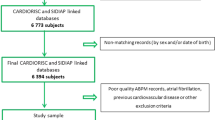Abstract
Aim:
The conventional method for analyzing 24-h ambulatory blood pressure monitoring (24-h ABPM) is insufficient to deal with the large amount of data collected. The aim of this study was to develop a novel cyclic fluctuation model for 24-h ABPM in Chinese patients with mild to moderate hypertension.
Methods:
The data were obtained from 4 independent antihypertensive drug clinical trials in Chinese patients with mild to moderate hypertension. The measurements of 24-h ABPM at the end of the placebo run-in period in study 1 were used to develop the cyclic fluctuation model. After evaluated, the structural model was used to analyze the measurements in the other 3 studies. Models were fitted using NONMEM software.
Results:
The cyclic fluctuation model, which consisted of 2 cosine functions with fixed-effect parameters for rhythm-adjusted 24-h mean blood pressure, amplitude and phase shift, successfully described the blood pressure measurements of study 1. Model robustness was validated by the bootstrap method. The measurements in the other 3 studies were well described by the same structural model. Moreover, the parameters from all the 4 studies were very similar. Visual predictive checks demonstrated that the cyclic fluctuation model could predict the blood pressure fluctuations in the 4 studies.
Conclusion:
The cyclic fluctuation model for 24-h ABPM deepens our understanding of blood pressure variability, which will be beneficial for drug development and individual therapy in hypertensive patients.
Similar content being viewed by others
Log in or create a free account to read this content
Gain free access to this article, as well as selected content from this journal and more on nature.com
or
References
Kanbay M, Turkmen K, Ecder T, Covic A . Ambulatory blood pressure monitoring: from old concepts to novel insights. Int Urol Nephrol 2012; 44: 173–82.
1999 World health organization-international society of hypertension guidelines for the management of hypertension. Guidelines subcommittee. J Hypertens 1999; 17: 151–83.
Chobanian AV, Bakris GL, Black HR, Cushman WC, Green LA, Izzo JL Jr, et al. The seventh report of the joint national committee on revention, detection, evaluation, and treatment of high blood pressure: the JNC 7 report. JAMA 2003; 289: 2560–72.
National Institution for Health and Clinical Excellence (NICE). Hypertension: the clinical management of primary hypertension in adults, 2011 Aug.[cited 2012 June 12]. Available from: http://www.nice.org.uk/nicemedia/live/13561/56008/56008.pdf.
Perloff D, Sokolow M . Ambulatory blood pressure measurements, prognostic implications. Archives des maladies du coeur et des vaisseaux 1991; 84: 21–7.
Bliziotis IA, Destounis A, Stergiou GS . Home versus ambulatory and office blood pressure in predicting target organ damage in hypertension: a systematic review and meta-analysis. J Hypertens 2012; 30: 1289–99.
Hansen TW, Kikuya M, Thijs L, Bjorklund-Bodegard K, Kuznetsova T, Ohkubo T, et al. Prognostic superiority of daytime ambulatory over conventional blood pressure in four populations: a meta-analysis of 7 030 individuals. J Hypertens 2007; 25: 1554–64.
Center for Drug Evaluation S. Guidance for clinical trials of new antihypertensive drugs. Beijing: [updated 2007 Aug 14; cited 2012 Aug 28]. Available from: www.cde.org.cn/attachmentout.do?mothed=list&id=378.
Hempel G, Karlsson MO, de Alwis DP, Toublanc N, McNay J, Schaefer HG . Population pharmacokinetic-pharmacodynamic modeling of moxonidine using 24-h ambulatory blood pressure measurements. Clin Pharmacol Ther 1998; 64: 622–35.
Troconiz IF, de Alwis DP, Tillmann C, Callies S, Mitchell M, Schaefer HG . Comparison of manual versus ambulatory blood pressure measurements with pharmacokinetic-pharmacodynamic modeling of antihypertensive compounds: application to moxonidine. Clin Pharmacol Ther 2000; 68: 18–27.
Li Y, Staessen JA, Lu L, Li LH, Wang GL, Wang JG . Is isolated nocturnal hypertension a novel clinical entity? Findings from a Chinese population study. Hypertension 2007; 50: 333–9.
Li Y, Wang JG, Gao P, Guo H, Nawrot T, Wang G, et al. Are published characteristics of the ambulatory blood pressure generalizable to rural Chinese? The JingNing population study. Blood Pressure Monitoring 2005; 10: 125–34.
Kelly TN, Rice TK, Gu D, Hixson JE, Chen J, Liu D, et al. Novel genetic variants in the alpha-adducin and guanine nucleotide binding protein beta-polypeptide 3 genes and salt sensitivity of blood pressure. Am J Hypertens 2009; 22: 985–92.
Li YY . alpha-Adducin Gly460Trp gene mutation and essential hypertension in a Chinese population: a meta-analysis including 10,960 subjects. PloS one 2012; 7: e30214.
Mancia G, De Backer G, Dominiczak A, Cifkova R, Fagard R, Germano G, et al. 2007 Guidelines for the management of arterial hypertension: the task force for the management of arterial hypertension of the European society of hypertension (ESH) and of the European society of cardiology (ESC). J Hypertens 2007; 25: 1105–87.
Lindbom L, Ribbing J, Jonsson EN . Perl-speaks-NONMEM (PsN) — a Perl module for NONMEM related programming. Comp Methods Program Biomed 2004; 75: 85–94.
Jonsson EN, Karlsson MO . Xpose — an S-PLUS based population pharmacokinetic/pharmacodynamic model building aid for NONMEM. Comp Methods Program Biomed 1999; 58: 51–64.
Hermida RC, Ayala DE, Chayan L, Mojon A, Fernandez JR . Administration-time-dependent effects of olmesartan on the ambulatory blood pressure of essential hypertension patients. Chronobiol Int 2009; 26: 61–79.
Lalonde RL, Kowalski KG, Hutmacher MM, Ewy W, Nichols DJ, Milligan PA, et al. Model-based drug development. Clin Pharmacol Ther 2007; 82: 21–32.
Acknowledgements
This study was supported by the National Key Technology R&D Program Project (2008BAI51B03), the National Key Project for IND (No 2012ZX09303-003 and 2012ZX09303009-001), and the Leading Academic Discipline Project of Shanghai Municipal Education Commission (No 085ZY1202, J50303, SZY11059 and ZYSNXD-CC-LCPJ). We also thank Dr Guang-li MA and Dr Jun-jie DING for providing guidance during the modeling process. The authors would like to thank Beijing Chao-Yang Hospital, Beijing Friendship Hospital, Beijing Xuanwu Hospital and Baotou Central Hospital for collecting the 24-h ABPM data.
Author information
Authors and Affiliations
Corresponding author
Rights and permissions
About this article
Cite this article
Sheng, Yc., Wang, K., Xu, L. et al. A cyclic fluctuation model for 24-h ambulatory blood pressure monitoring in Chinese patients with mild to moderate hypertension. Acta Pharmacol Sin 34, 1043–1051 (2013). https://doi.org/10.1038/aps.2013.45
Received:
Accepted:
Published:
Issue date:
DOI: https://doi.org/10.1038/aps.2013.45
Keywords
This article is cited by
-
Visit-to-visit Systolic Blood Pressure Variability and Stroke Risk: A Systematic Review and Meta-analysis
Current Medical Science (2019)



